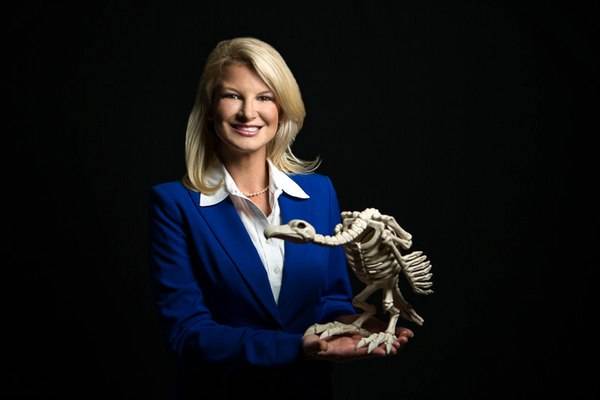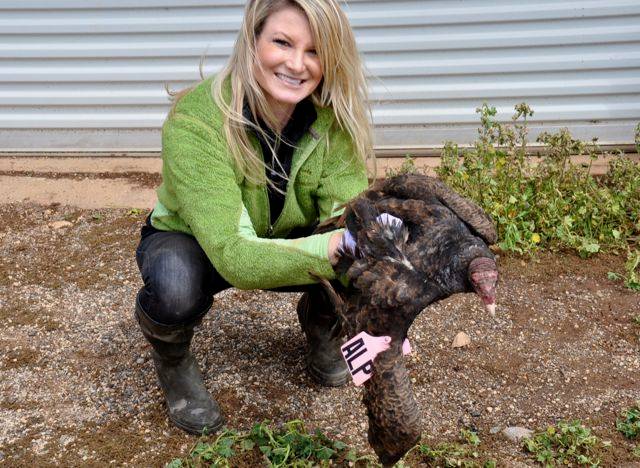Vulture Culture: National Science Foundation Funds LSU Graduate Student's Forensic Vulture Research
Prestigious dissertation enhancement grant supports Lauren Pharr's vulture scavenging work at Texas State University's Forensic Anthropology Research Facility (FARF).
It’s a scene reminiscent of old Westerns: a blue sky marred only by a vulture circling overhead, representing death and decay. But most film buffs – and the rest of us, for that matter – probably don’t realize that studying the frequency and pattern of vulture scavenging can actually have an impact on missing persons’ cases and other forensic studies. And that’s just what LSU graduate student Lauren Pharr has dedicated her career toward.
“Vultures really are fascinating creatures,” said Pharr. “They’re a protected species and not many people actually study them, even though their scavenging is actually really important to our ways of understanding decomposition.”
Pharr, a native of Memphis, Tenn., has been awarded the highly prestigious National Science Foundation, or NSF, Dissertation Enhancement Grant for her research focusing on vulture scavenging at a forensic anthropology research facility, or “body farm,” in San Marcos, Texas. Her research combines forensic anthropology and geographic information systems, or GIS. It focuses on the scavenging rates of vultures at the Texas State Forensic Anthropology Research Facility, or FARF, and the use of satellite telemetry to isolate probable scavenging locations. Her work will test the hypothesis that land elevation and distance to water will have the greatest impact and that FARF is a vulture scavenging hotspot regardless of the underlying geography. Data from locations where vultures are observed scavenging in the wild will be used to validate the model.
Satellite telemetry involves the application of GPS transmitters to the animal under investigation and then satellites are used to transmit the animals’ locations and corresponding altitude to the research. Pharr’s dissertation research is unique because she plans to use the recorded altitude data to isolate probable vulture scavenging locations.
This research is important to law enforcement because investigators across the United States rely on accurate “time since death estimations” to help narrow down missing persons files to be searched, and also to either confirm or refute a suspects alibi. As a result, determining the accuracy of vulture scavenging rates at FARF is critical in insuring that law enforcement are applying appropriate timeline data to homicide investigations.
“I’m also working to see if scavenging near FARF is indicative of real-world situations,” said Pharr. “Because of the nature of the research conducted there, it could be that the area is more attractive to vultures than other areas might be.”
Pharr spent the summer of 2011 studying the scavenging rates of vultures at FARF versus the vultures’ scavenging rates at offsite non-forensic locations to determine if the vultures’ scavenging behavior has been altered by the repetition of decomposition studies taking place at FARF. In early summer 2012, Pharr will begin the process of trapping vultures at FARF and fitting the vultures with GPS transmitters prior to their release.
Deceased pigs from the LSU swine unit serve as “vulture bait,” an integral part of Pharr’s research.
“My work would not be possible without the assistance of Rebecca Lirette, director of the LSU swine unit,” she said.
Once the pigs are scavenged, all the bones are collected and then transported back to LSU, where they are currently undergoing analysis to determine if there is a consistency to the marks that vultures will leave on bones. Through the use of self-activating wildlife cameras that record the vultures’ scavenging behavior, researchers now know that vultures accelerate decomposition at rates exceeding those reported in the literature for other scavengers, but how does one go about determining that vultures skeletonized the unidentified remains when cameras are not present to record this behavior?
“That’s the million dollar question, and I hope to help answer it by analyzing the postmortem scavenging marks vultures leave on bones,” said Pharr. A result the first overall objective of this research is to combine the results from the GIS and osteological analysis to establish a foundational scavenging database detailing when and where vultures scavenge and which clues they leave behind.
“I plan to use the database I develop to create a vulture scavenging decision table that law enforcement and forensic investigators can use at outdoor sites to help determine if vultures scavenged the unidentified remains in question,” she said.
Pharr uses camera equipment from LSU’s Studio 151 to photograph the scavenged bones, regularly working with Professor of English Marvin Broome.
Pharr received her bachelor’s degree in anthropology from the University of Tennessee and her master’s degree in anthropology from LSU. Pharr’s research for her master’s focused on forensic anthropology and the decomposition rates of remains concealed within 55-gallon oil drums.
Her dissertation, titled “Using GPS to Investigate Vulture Scavenging at a Forensic Anthropology Facility in Texas,” is led by her advisor, LSU Professor of Geography & Anthropology Michael Leitner.
“Lauren is in her third year as a doctoral student at LSU. What has impressed me the most about her is her strong will power to reach a goal that she has set for herself, independent of how difficult it is to reach that goal,” said Leitner. “No other student of mine has written more grant proposals or has presented at more conferences. She is a confident person that does not take ‘no’ for an answer, works very independently and is a very quick study. Because of these attributes, I believe that she has a great potential as a professional and can truly become anything that she wants to become.”
To read more about Pharr’s research, visit http://nsf.gov/awardsearch/showAward.do?AwardNumber=1203680.
Source of this article: http://www.lsu.edu/departments/gold/2012/06/vulture.shtml#!prettyPhoto



